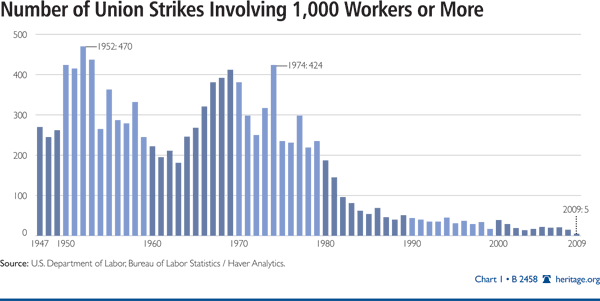Abstract: Unions have been a familiar part of American working life for more than 70 years. Less familiar is the state of the union movement today: More union members now work for the government than for private employers. The above-market salaries and benefits that government employees receive are paid for by taxpayers. So, the union movement that began as a campaign to improve working conditions and salaries for workers in the private sector, now pushes for ever-higher taxes to increase the generous compensation that government employees enjoy. Heritage Foundation labor policy expert James Sherk details the changes in the union movement, and explains how Congress can react to this new reality.
The American union movement has reached a historic milestone—more union members currently work for the government than for private businesses. As a result, the union movement’s priorities have shifted. Because taxes fund government pay and benefits, unions are now pushing for tax increases across the country. The union movement that once campaigned to raise private-sector workers’ wages has transformed into a government union movement that campaigns to raise their taxes.
How did this happen? Union organizing surged after the passage of the National Labor Relations Act (NLRA) in 1935. But because union contracts raise costs, unionized businesses generally grow more slowly than non-union firms. Market competition has caused union membership to gradually fall in the private sector since the 1950s. The new government unions created in the 1960s could safely demand inflated pay without putting their jobs at risk. Now most union members work for the government.
The early trade unionists did not believe that unions had a place in government. They believed the purpose of unions was to redistribute profits from business owners to workers—and the government makes no profits. The government labor movement has become a powerful special interest lobby to raise taxes on working Americans to raise the level of compensation for government workers. Taxpayers should not have to subsidize this lobbying. Congress should prohibit federal unions from using the federal payroll system to automatically deduct union dues from government employees’ paychecks.
New Government Labor Movement
The American labor movement marked a historic shift in 2009. For the first time in U.S. history, more union members worked for the government than worked in the private sector. The U.S. Postal Service employs three times as many union members as the domestic auto industry.[1] Table 1 shows union membership in the United States in 2009 and through the first seven months of 2010.
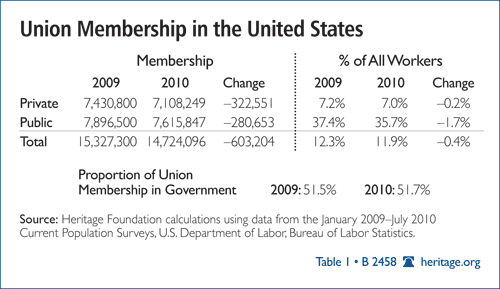
Overall union membership dropped again in the first half of 2010: down by 603,000 members to 11.9 percent of all employees. Private-sector and public-sector unions both lost members. Private-sector unions lost 323,000 members, dropping to 7 percent of the private-sector workforce. A smaller proportion of private-sector workers belong to unions now than at any point since the Supreme Court upheld the National Labor Relations Act. Union membership also fell by 281,000 members in government, dropping by 1.7 percent of the government workforce.
However, well over one-third (35.7 percent) of government employees still belong to a union. The 7.6 million union members who work for the government make up 51.7 percent of all union members in the United States. The new face of the union movement is the clerk at the Department of Motor Vehicles, not the worker on the assembly line.
Private-Sector Strikes Rare. As the labor movement’s membership has moved toward government, so have its priorities. Labor unions once focused on improving private-sector working conditions, but now their efforts have shifted toward increasing government pay and benefits.
The frequency of private-sector strikes demonstrates the union movement’s changed priorities. Threatening strikes is the main tool that unions use to win concessions from private employers. Now strikes have become exceedingly rare.
Unions used to launch hundreds of strikes a year—often at considerable cost to the economy. In 2009, unions initiated only five major strikes that involved 1,000 workers or more. The recession does not explain why unions so rarely strike. In 2007, the last year before the recession, unions engaged in just 21 strikes.
New Labor Priority: Political Influence. The union movement’s priorities have shifted from the picket line to politics. Many government unions are prohibited from striking by law, so to raise government pay unions must influence the legislative processes that determine their wages.
The union movement has ample money at its disposal. In states without right-to-work laws, unionized employees must pay union dues or lose their jobs. State and local governments use their payroll systems to collect dues for the union. The government automatically deducts the dues— typically 1 percent to 2 percent of a government employee’s pay—and deposits it in the union’s bank account.
One percent of the pay of several hundred thousand government workers is a lot of money. The New Jersey Education Association has 179,000 active members who each have to pay union dues of $761 every year.[2] That works out to more than $136 million in dues a year. The American Federation of State and County Municipal Employees (AFSCME) national headquarters brought in $193 million in union dues in 2008. AFSCME’s local affiliates raised hundreds of millions more.[3]
The union movement spends much of this money on politics. In election year 2008, AFSCME spent $63 million on political campaigning and lobbying. That was 32 percent of its overall budget and well more than the $39 million it spent representing its members.[4] In 2009, the American Federation of Labor and Congress of Industrial Organizations (AFL–CIO) spent $29 million on representational activities and $47 million on political campaigning and lobbying.[5] The amount spent on politics represented 25 percent of the AFL–CIO’s budget.[6] The AFL–CIO and the Service Employees International Union (SEIU) just announced their intention to spend $100 million on electing sympathetic candidates in this year’s midterm elections.[7]
This political spending gives unions considerable political influence. Government unions use this influence to press Congress and state legislatures to raise government salaries and to hire more employees. They have largely succeeded. The average government employee earns more than his counterpart in the private sector.
Government Pays More. The average federal employee earns hourly cash wages 22 percent above what a similar private-sector worker receives. Adding in the value of non-cash benefits raises the federal compensation premium to between 30 percent and 40 percent a year.[8]
Unions have also successfully raised the pay of state and local government employees. While their hourly wages are no higher—and in some cases slightly lower—than those of similar private-sector workers, they make up for it with benefits. Specific benefit packages vary across states, but state and local employees generally have excellent health coverage to which they contribute little. They also receive generous pensions unavailable to most private-sector employees. Many state and local government employees can retire in their 50s with a substantial defined-benefit pension.
In California, state employees can retire at 55 with a pension worth 2 percent of their highest year’s earnings multiplied by their years of service. California highway patrol officers get an even better deal; they can retire at 50 with 3 percent of their final salary multiplied by their years of service.[9] That means that a worker with 30 years of experience can retire in his 50s and enjoy 90 percent of what he earned on the job until he dies. Including the value of these benefits, state and local employees’ total compensation is significantly higher than that of private-sector workers.[10]
Government Job Security. Government unions have won another perk for their members that few workers in the private sector enjoy: extremely high job security. Federal law makes termination of ineffective government employees extremely difficult.[11] Many states have similar civil service codes that make it difficult to fire underperforming government workers. The Chicago Teachers Union, for example, filed a lawsuit after the Chicago public school system responded to budget cuts by laying off teachers with “unsatisfactory” performance ratings.[12] The union insists that all layoffs must occur on the basis of seniority, not performance.
Government employees also have less reason to worry about elimination of their jobs during a recession. Since the start of this current recession in December 2007, private-sector employment has fallen by 6.8 percent. Federal employment, however, has risen by 10 percent while state and local government employment has only fallen slightly. Taxes and deficit spending have kept government payrolls going even as the economy has experienced its worst slump since the Great Depression. Government employees generally experience little of the uncertainty of a recession.
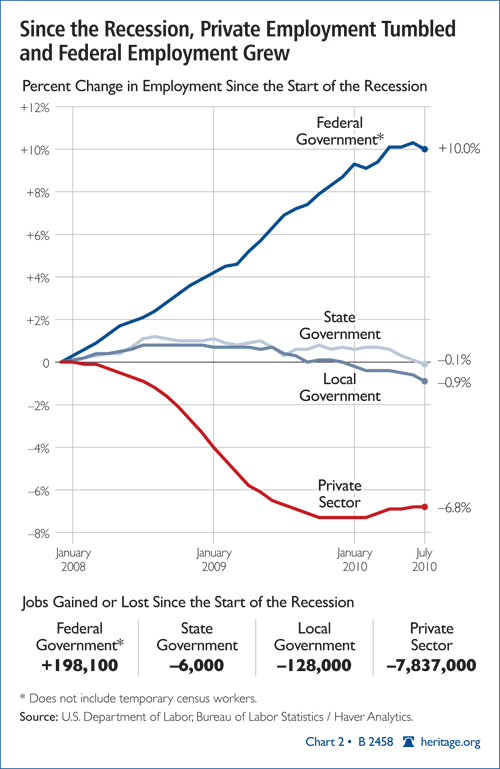
Government Pay Costs Taxpayers. The cost for such generous pay and benefits is great. Paying federal employees’ inflated compensation will cost taxpayers $47 billion in 2011.[13] Nonpartisan estimates indicate that state and local retiree health care and pension plans face a cumulative $3.1 trillion funding shortfall.[14] The money to cover these costs comes from taxes. The more taxes the government collects the more employees it can hire and the more it can pay them. Since most union members work for the government, unions strongly support higher taxes. The federal pay premium alone takes up 5 percent of federal income tax revenues.[15]
Government Unions Campaign for Tax Increases. The union movement now consists primarily of government employees lobbying for more government and higher taxes. An examination of union activity across the country illustrates the union movement’s strong advocacy for tax increases:
- Arizona . Public-sector unions spent more than $200,000 to campaign for a successful ballot measure in May 2010 that raised the state sales tax by 1 percent.[16] The Arizona Education Association also successfully lobbied against a repeal of a $250-million-a-year statewide property tax in 2009.[17]
- California . The California Teachers Association spent $2 million gathering signatures for an initiative on the November 2010 ballot that would raise business taxes by $2 billion a year.[18] Separately, public employee unions protested at the state capitol demanding the legislature raise taxes by $40 billion a year, including raising the top state income tax bracket to 11 percent, applying the sales tax to services in addition to goods, and increasing the state’s vehicle license fee by 2 percentage points.[19]
- Colorado . Led by the National Education Association’s $450,000 contribution, government unions spent $806,000 campaigning for a failed 2008 ballot initiative to roll back taxpayer rebates and use that money to increase education spending.[20] That year, government labor unions also gave $244,000 to a committee campaigning for Amendment 58, an initiative that would have raised taxes on oil and natural gas companies had the voters not defeated it.[21]
- Delaware . Democratic Governor Jack Merkle proposed closing the state’s budget gap in 2009 with an 8 percent across-the-board cut in state employee pay. In response, labor unions united in a large coalition (State Workers United for a Better Delaware) to oppose the pay reductions. The coalition pressed the governor to look to tax increases instead of cutting government union members’ pay.[22] The legislature ultimately cut state employee pay by 2.5 percent.
- Florida . The Florida Education Association unsuccessfully lobbied for a 1 percent increase in the state sales tax in 2009.[23] Labor unions also spent $1.3 million in an unsuccessful attempt to defeat a 2008 ballot initiative that expanded the state’s property tax exemption.[24]
- Georgia . The Georgia Association of Educators, the state-level affiliate of the National Education Association, has begun campaigning for a 0.5 percent increase in the state sales tax.[25]
- Hawaii . The Hawaii State Teachers Association is campaigning for a $500 million annual hike in state taxes, including increasing the top state income tax to 13 percent and raising business and capital gains taxes.[26]
- Idaho . Government labor unions spent more than $2 million promoting an unsuccessful ballot initiative in 2006 that would have raised the state sales tax by 1 percent and directed that money to public education.[27]
- Illinois . AFSCME Council 31 and other government unions are pressing the state legislature to close the deficit with a $6.4 billion tax increase instead of cutting spending. The unions want state lawmakers to increase the state income tax from 3 percent to 5 percent and to expand the sales tax to cover certain commercial services.[28] The unions spent heavily in 2009 on television and radio ads pressing for these tax increases. In April 2010, government unions organized rallies outside the state capitol shouting, “Raise my taxes! Raise my taxes! Raise my taxes!”[29] At that rally, a government union member was caught on camera chanting, “Where’s the money?” and “Give up the bucks!”[30] In July 2010, 40,000 unionized state government employees received a 7 percent raise and are scheduled to receive another 7 percent raise in 2011. These raises will cost Illinois taxpayers $500 million.[31]
- Iowa . In 2009, AFSCME Council 61 unsuccessfully fought for tax increases instead of requiring state employees to take a five-day furlough. In the eyes of the union’s president, the state’s deficit “is not a spending issue, this is a revenue issue.”[32]
- Kansas . The Kansas Organization of State Employees boasts that it “mobilized more than 300 activists for a Lobby Day in February and formed ‘gauntlets’ outside each chamber in order to prevent spending cuts that would have eliminated 1,000 government jobs, urging wavering legislators to stand with them. They were relentless and creative—flooding House and Senate offices with hundreds of phone calls, faxes and e-mails, and utilizing social media to provide Twitter updates and action alerts.” They were successful. In May 2010, the Kansas legislature passed a budget that raised the state sales tax by 1 percent. The budget also raised the pay of many state employees between 2 percent and 10 percent.[33]
- Maine . Maine citizens voted on a ballot initiative in November 2009 that would prevent government spending from growing faster than the combined rate of inflation and population growth and would require the government to return excess revenues as tax rebates. The Maine Municipal Association, the SEIU, the Teamsters, and the Maine Education Association collectively spent hundreds of thousands of dollars to campaign against the initiative, and it was ultimately defeated by a wide margin.[34] In 2010, government unions lobbied state legislatures to raise the state sales tax by 1 percent, or the state cigarette tax by $0.50 per pack.[35]
- Maryland . Maryland added four new state income tax brackets in 2008. That was not enough for government labor unions. The state affiliate of AFSCME lobbied the legislature to raise taxes by another $2 billion, including expanding the state sales tax to cover additional services and increasing alcohol and gas taxes.[36]
- Michigan . Government unions, including members of the AFL–CIO, the Michigan Education Association, and the Michigan Nurses Association launched “A Better Michigan Future” campaign in September 2009. They called for a $2.7 billion tax increase. Their proposals included expanding the state sales tax to cover a variety of services, and raising the top state income tax rate from 4.35 percent to 6.9 percent. The Michigan legislature decided against raising taxes in a state badly hit by the recession.
- Minnesota . AFSCME Council 5 unsuccessfully lobbied state legislators to override Governor Tim Pawlenty’s veto of a $1 billion tax increase in spring 2009.[37] In December 2009 Council 5 lobbied for a $3.8 billion tax increase.[38]
- Montana . The Montana Education Association– Montana Federation of Teachers (MEA–MFT) union openly portrays itself as a supporter of tax-and-spend politics. As MEA–MFT president Eric Feaver boasted, “Were it not for us almost any one of the…anti-tax-and-spend ballot issues proposed in the last 25 years would have passed.”[39] The union pursued tax-and-spend politics in 2009, unsuccessfully lobbying the state legislature to raise taxes on oil and gas companies.[40] The MEA–MFT also lobbied the legislature for a 6 percent raise for state workers. Despite the recession, it did not come away completely empty-handed. The final plan boosted government employee compensation, although not as much as the union wanted. As the union put it, “the pay plan amounts to $24 million in new money for state employees, and that’s no small change at a time when the economy is crashing.”[41]
- Nebraska . Labor unions contributed 60 percent of the $2.5 million spent in 2006 to defeat Nebraska Measure 423. The ballot initiative drew the fire of government unions because it would have capped state spending based on population growth and inflation.[42]
- New Jersey . Newly elected Governor Chris Christie took office in 2010 facing an $11 billion budget deficit. He closed the deficit without raising taxes by reducing spending. This drew the fire of government unions in New Jersey, especially the New Jersey Education Association, which opposed the governor’s proposal to freeze teacher pay and require teachers to contribute 1.5 percent of their salary toward their health insurance premiums. Up to then they contributed nothing. The union spent heavily on television, radio, and print advertisements critical of the governor.[43] Public-sector unions in New Jersey also fought to keep the state’s top income tax from falling to 9 percent from 10.75 percent and against a proposed cap on property tax increases. The leadership of Communication Workers of America (CWA) District 1—a union representing 40,000 state workers—proposed raising member dues to fund a $2 million advertising campaign against Christie. Union membership, however, voted against the proposal by 62 percent to 38 percent.[44]
- New Mexico . The New Mexico AFSCME local lobbied the state’s legislature to raise taxes to deal with its budget deficit.[45] The union got its wish, but it was not the wealthy who paid. The legislature increased the state’s gross receipts tax on goods and services and reinstated a 2 percent sales tax on food.[46]
- New York . New York government unions spent millions of dollars in 2009 on television ads opposing Governor David Paterson’s property tax cap plan and attacking his budget that did not contain the tax increases they wanted.[47] After heavy lobbying, the governor finally agreed to raise taxes to help close the budget shortfall. Among other tax increases, he raised the state’s top income tax rate to 9 percent and the combined state and New York City income tax to 12.85 percent.[48] Unionized employees at the Metropolitan Transit Authority were not complaining: more than 8,000 of them made over $100,000 in 2009, including one recently retired rail conductor who pulled in $239,000 in his final year on the job.[49]
- North Dakota . Government unions, including the National Education Association and the North Dakota Public Employees Association spent $500,000 to defeat two ballot initiatives in 2008. One would have reduced the state’s income tax by 50 percent; the second would have established a trust fund for oil and gas tax revenues.[50]
- Ohio. SEIU District 1199 produced and ran advertisements campaigning for a rollback of scheduled income tax cuts. They wanted taxes to remain higher to prevent government spending cuts.[51] In Columbus, AFSCME pushed a referendum on a 0.5 percent increase in the city income tax to victory. The union boasted that “members of Locals 1632 and 2191 stepped up to the plate, helping to make thousands of phone calls to potential voters and delivering 5,000 door hangers to homes in high-turnout Democratic precincts.… The efforts of Council 8 members proved essential: Out of more than 89,000 votes cast in last summer’s special election, the tax increase passed with a margin of just 3,050 votes.”[52]
- Oklahoma. The Oklahoma Education Association placed Question 744 on the November 2010 ballot. The measure would increase spending on public schools by $1 billion, necessitating tax increases or spending cuts elsewhere to balance the state’s budget.[53]
- Oregon. Public-sector unions provided over 80 percent of the $8 million spent to pass Measures 66 and 67 in January 2010, ballot initiatives that raised income and business taxes by $727 million.[54] Government unions outspent the business community by a three-to-two margin to pass the new taxes.[55] However the tax increases have not solved the state’s budget crisis. State budget analysts have estimated that the state still faces a $577 million shortfall.[56]
- Pennsylvania. Unions representing 1.1 million Pennsylvania workers have created the Coalition for Labor Engagement and Accountable Revenues (CLEAR). The union coalition wants Pennsylvania lawmakers to “find new fair and equitable revenue sources to fill the state’s budget gap and not close the gap by cutting services.” The coalition particularly warns that the state should not furlough government employees, privatize their jobs, or reduce the retirement benefits of state employees.[57]
Unions consistently press for higher taxes and more government spending across America. The labor movement has made higher taxes and more government spending one of its top priorities. But unions are self-interested advocates of tax increases: They oppose tax increases that significantly affect their members. During the congressional debate over health care reform, for example, the union movement lobbied heavily against taxing high-value health care plans. Union members tend to have generous health coverage, and that tax would fall heavily on them. That is especially true of government union members. The union movement threatened to oppose the entire health care bill unless Congress scaled back that tax increase. Congress did so.
Conflict of Interest. Labor unions’ political activism creates a conflict of interest in government. In the private sector, employer pressure to cut costs balances excessive union wage demands. In the government, unions can use their political influence to elect sympathetic politicians, and then labor and management work together to raise government pay. No one at the bargaining table speaks for the taxpayers.
Departure from Labor’s Roots
This shift to government has brought the union movement far from its historical roots. The 19th-century founders of the U.S. labor movement believed that the profit motive would lead employers to exploit workers. They saw unions as a vehicle to get workers a greater share of the profits that they helped to create.[58] The economic tool they used to do this was the strike.
However, this model does not apply in government. The state does not earn profits that it divides between shareholders and labor. For the same reason, the government has no incentive to pay low wages. A strike by government workers would interrupt vital functions such as police protection and education. Consequently, the founders of the labor movement did not believe the union movement had a place in government and they did not attempt to organize government workers.
Some labor leaders rejected government unions as intrinsically undemocratic. Collective bargaining gives government employees the power to tell voters how to spend their tax dollars instead of the other way around. As recently as 1959, the AFL–CIO Executive Council stated that “government workers have no right [to collectively bargain] beyond the authority to petition Congress—a right available to every citizen.”[59]
Rise of Private-Sector Unions. When Congress passed the National Labor Relations Act in 1935 to encourage collective bargaining, the NLRA did not apply to government employees. Union leaders at the time believed this made perfect sense. As former AFL–CIO president George Meany wrote in 1955, “it is impossible to bargain collectively with the government.”[60] The man who created the AFL–CIO would not recognize today’s union movement.
Only a small portion of workers belonged to unions until Congress passed the NLRA. The act promoted collective bargaining in the private sector by requiring management to bargain with unions as workers’ “exclusive bargaining representative.” Once the Supreme Court upheld the constitutionality of the NLRA in 1937, union membership grew rapidly. By 1947, 24 percent of the labor force belonged to unions.[61]
This gave labor unions great economic power, but they did not always use it responsibly. The United Mine Workers aroused national outrage when they shut down coal production in 1943, harming the war effort. Postwar strikes in the steel, coal, and auto industries paralyzed large portions of the economy. Congressional investigations also uncovered ties between major unions and organized crime.
These actions caused public support for unions to cool, and Congress passed the Taft–Hartley Act in 1947 to address union abuses. When Congress passed the NLRA 12 years earlier, it had not foreseen that some unions would pressure workers into unionizing. Taft–Hartley complemented the NLRA’s protection of the ability to bargain collectively by protecting workers’ rights to choose not to do so. The act established the secret ballot as the normal means of unionizing, gave workers the right to decertify their union, and prohibited many forms of economic pressure that unions applied to workers who did not want to unionize.[62]
Chart 3 shows union membership as a percentage of the labor force from two separate data sets collected by the Department of Labor.[63] Union membership peaked at 26 percent of the labor force in 1953, and has gradually declined since then.
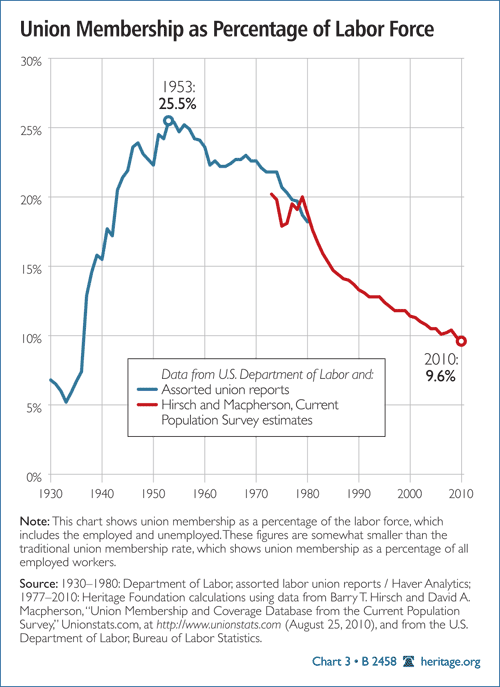
Creation of Government Unions. Wisconsin became the first state to pass a law permitting government employees to collectively bargain in 1959. This followed the decision of New York City’s Mayor Robert Wagner to do the same in 1958.[64] In 1962, President John F. Kennedy signed Executive Order 10988 that permitted collective bargaining with federal employees.
Throughout the 1960s and the 1970s, collective bargaining rapidly spread throughout state and local governments. To prevent public-sector strikes, most states established binding arbitration for government unions. These laws vary across states, but under binding arbitration, contract disputes between the government and government unions are decided by an arbitrator who hands down a binding contract.
Competition Eroded Private-Sector Unions. At the same time that unions were rapidly organizing government workers, market competition began undermining unions in the private sector. Unions raise business costs.[65] This, and the fact that unionized companies invest less in capital and research and development, makes unionized firms less competitive.[66] This does not hurt unions if their competitors are unionized or they compete in heavily regulated markets.
But in the 1970s and 1980s, Congress made the U.S. economy much more competitive. Deregulation and free trade forced many unionized firms to compete against more efficient non-union firms. They could not keep up. Non-union businesses charged less than unionized firms and won their customers.
Across the country non-union manufacturing, construction, and trucking companies grew while their unionized competitors shrank. Between 1973 and 1998, non-union jobs grew by roughly 3 percent a year while 3 percent of union jobs disappeared annually.[67] Competitive pressures have steadily shrunk private-sector unions to their current levels: 7 percent of all private-sector workers and 6 percent of the private-sector labor force.
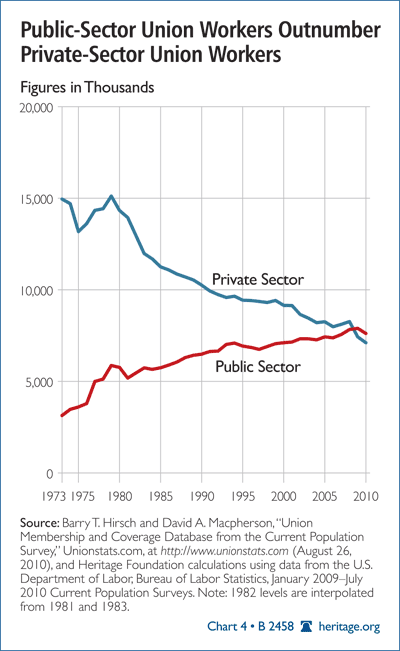
Government Unions Immune to Competition. Competitive forces have not undercut government unions: The government has no competition. It has a monopoly on providing its services. Taxpayers cannot purchase less expensive police or education services from another state without moving there.
Consequently, government unions can negotiate generous benefits without worrying about putting their jobs at risk. Unlike the private sector, governments almost never go bankrupt. They can always raise taxes to cover their costs. So once unions organize a government department, those workers remain organized.
By 1977, a total of 35 states had passed legislation regulating collective bargaining with state employees.[68] That year, 33 percent of government employees belonged to unions, which accounted for 26 percent of all U.S. union members. Since then, government union rates have stayed in the mid to high 30 percent range.[69] Even as private-sector unions have lost members, public-sector unions have grown. In 2009, those paths crossed and now most union members work for the government.
What Congress Should Do
The union movement has transformed over the past generation; it now primarily represents government employees. Three times as many union members now work for the U.S. Postal Service as for the auto industry. The mandatory union dues that the government collects on behalf of its unionized employees raise billions of dollars a year. The union movement spends a substantial amount of this money aggressively advocating higher taxes and increased government spending.
This creates a situation in which both government labor and management have an incentive to promote higher taxes. Congress should take several steps to restore equity between government employees and taxpayers:
- Congress should recognize that the union call for raising taxes to pay for more and more highly paid government employees is narrowly self-interested. Congress should reject union lobbying for tax increases. Every major school of economic thought agrees that the government should not raise taxes during a recession. Congress should not raise taxes to insulate unionized government employees from the recession.
- Congress should reduce the pay of federal employees to market rates. Congress can do so by adopting performance pay based on market signals of labor demand, hiring more contractors, and reducing the generosity of federal employee benefits. This would save taxpayers $47 billion in 2011.[70]
- Congress should not force states that do not collectively bargain to begin doing so. Legislation currently before Congress, the Public Safety Employer–Employee Cooperation Act of 2009 (H.R. 413, S. 3194), would require all states and local governments to collectively bargain with police and firefighters. Congress should respect the decisions of states that find government unionism counterproductive.
- Congress should stop requiring taxpayers to subsidize the collection of government union dues. The federal government uses its payroll system to automatically deduct the dues of federal union members from their paychecks. Federal unions use these dues to lobby for higher taxes. Unions should use their own resources to collect dues from their members. Congress should end the automatic deduction of federal union dues.
Congress should adapt the law to appropriately respond to the reality of the new government union movement. It is the right thing to do.
—James Sherk is Senior Policy Analyst in Labor Economics in the Center for Data Analysis at The Heritage Foundation.
